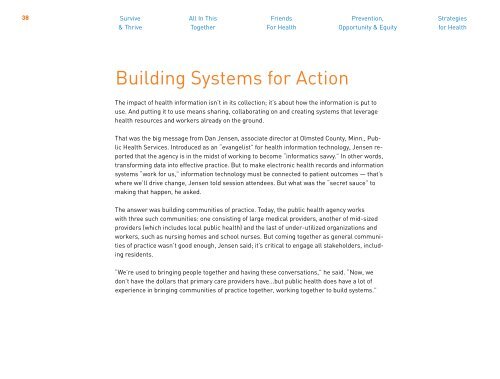INSIGHT & INSPIRATION FROM APHA’S 2012 MIDYEAR MEETING
INSIGHT & INSPIRATION FROM APHA’S 2012 MIDYEAR MEETING
INSIGHT & INSPIRATION FROM APHA’S 2012 MIDYEAR MEETING
Create successful ePaper yourself
Turn your PDF publications into a flip-book with our unique Google optimized e-Paper software.
38<br />
Survive All In This Friends Prevention, Strategies<br />
& Thrive Together For Health Opportunity & Equity for Health<br />
Building Systems for Action<br />
The impact of health information isn’t in its collection; it’s about how the information is put to<br />
use. And putting it to use means sharing, collaborating on and creating systems that leverage<br />
health resources and workers already on the ground.<br />
That was the big message from Dan Jensen, associate director at Olmsted County, Minn., Public<br />
Health Services. Introduced as an “evangelist” for health information technology, Jensen reported<br />
that the agency is in the midst of working to become “informatics savvy.” In other words,<br />
transforming data into effective practice. But to make electronic health records and information<br />
systems “work for us,” information technology must be connected to patient outcomes — that’s<br />
where we’ll drive change, Jensen told session attendees. But what was the “secret sauce” to<br />
making that happen, he asked.<br />
The answer was building communities of practice. Today, the public health agency works<br />
with three such communities: one consisting of large medical providers, another of mid-sized<br />
providers (which includes local public health) and the last of under-utilized organizations and<br />
workers, such as nursing homes and school nurses. But coming together as general communities<br />
of practice wasn’t good enough, Jensen said; it’s critical to engage all stakeholders, including<br />
residents.<br />
“We’re used to bringing people together and having these conversations,” he said. “Now, we<br />
don’t have the dollars that primary care providers have...but public health does have a lot of<br />
experience in bringing communities of practice together, working together to build systems.”



